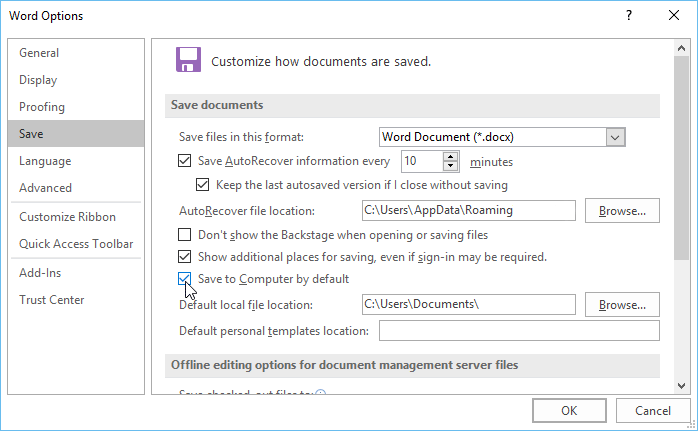

When you create a new document in Word, you'll need to know how to save it so you can access and edit it later. As with previous versions of Word, you can save files to your computer. If you prefer, you can also save files to the cloud using OneDrive. You can even export and share documents directly from Word.
Watch the video below to learn how to save and share Word documents.
Word offers two ways to save a file: Save and Save As. These options work in similar ways, with a few important differences.
Most features in Microsoft Office, including Word, are geared toward saving and sharing documents online. This is done with OneDrive, which is an online storage space for your documents and files. If you want to use OneDrive, make sure you’re signed in to Word with your Microsoft account. Review our lesson on Understanding OneDrive to learn more.
It's important to save your document whenever you start a new project or make changes to an existing one. Saving early and often can prevent your work from being lost. You'll also need to pay close attention to where you save the document so it will be easy to find later.



You can also access the Save command by pressing Ctrl+S on your keyboard.
If you want to save a different version of a document while keeping the original, you can create a copy. For example, if you have a file named Sales Report, you could save it as Sales Report 2 so you'll be able to edit the new file and still refer back to the original version.
To do this, you'll click the Save As command in Backstage view. Just like when saving a file for the first time, you'll need to choose where to save the file and give it a new file name.

If you don't want to use OneDrive, you may be frustrated that OneDrive is selected as the default location when saving. If you find this inconvenient, you can change the default save location so This PC is selected by default.



Word automatically saves your documents to a temporary folder while you are working on them. If you forget to save your changes or if Word crashes, you can restore the file using AutoRecover.

By default, Word autosaves every 10 minutes. If you are editing a document for less than 10 minutes, Word may not create an autosaved version.
If you don't see the file you need, you can browse all autosaved files from Backstage view. Select the File tab, click Manage Versions, then choose Recover Unsaved Documents.

By default, Word documents are saved in the .docx file type. However, there may be times when you need to use another file type, such as a PDF or Word 97-2003 document. It's easy to export your document from Word to a variety of file types.
Exporting your document as an Adobe Acrobat document, commonly known as a PDF file, can be especially useful if you're sharing a document with someone who does not have Word. A PDF file will make it possible for recipients to view—but not edit—the content of your document.


If you need to edit a PDF file, Word allows you to convert a PDF file into an editable document. Read our guide on Editing PDF Files for more information.
You may also find it helpful to export your document to other file types, like a Word 97-2003 Document if you need to share with people using an older version of Word or a .txt file if you need a plain-text version of your document.


You can also use the Save as type drop-down menu in the Save As dialog box to save documents to a variety of file types.

Word makes it easy to share and collaborate on documents using OneDrive. In the past, if you wanted to share a file with someone you could send it as an email attachment. While convenient, this system also creates multiple versions of the same file, which can be difficult to organize.
When you share a document from Word, you're actually giving others access to the exact same file. This lets you and the people you share with edit the same document without having to keep track of multiple versions.
In order to share a document, it must first be saved to your OneDrive.

Click the buttons in the interactive below to learn more about different ways to share a document.

edit hotspots
Here, you can select who's allowed to access your file, whether you want to allow editing, and the option to include an expiration date for the file.
Type the name or email address of the person you'd like to share your file with here.
If you'd like to include a message with your file, you can type it here.
Click Send to send your file to its recipient(s).
Click Copy Link to copy a URL that you can send to others via email, messaging, or any other method.
If you'd prefer to use Outlook, click here to send your file through an email.
You can use this option if you'd prefer to send a copy so the recipient isn't editing the same file as you.
![]()
![]()
![]()
This website uses cookies to measure and analyze our traffic. For more information about the cookies we use, see our Terms of Use. If you want to change your decision later on, select the 'Cookie Policy' link in the footer.